

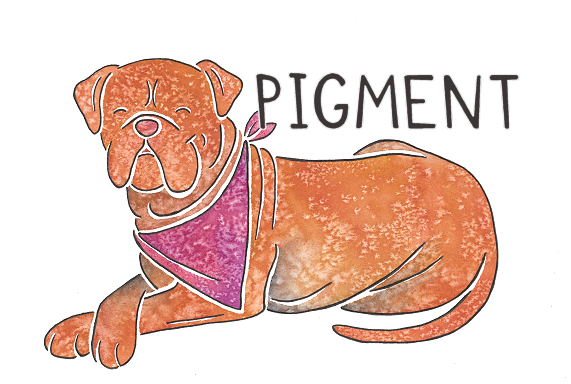
Two Different Types of Pigment
The key to understanding dog genetics is simply this: there are two types of pigment that create coat colour in dogs (and most other mammals). Pigment is the thing that gives each strand of hair its colour, just like pigment in paint or dye, or pigment in your own hair or skin. All coat colours and patterns in dogs are created by these two pigments, which are both forms of melanin. Each of the pigments has a "default" colour, and it can then be modified by various genes.
Melanin plays a big part in the colour of almost all animals, even humans. Dark human skin has a higher density of melanocytes (pigment cells producing melanin), and light human skin has a lower density (or in some cases the melanocytes are faulty, reducing the amount of pigment they produce).

Already know what you're looking for? Quick Links |

Eumelanin

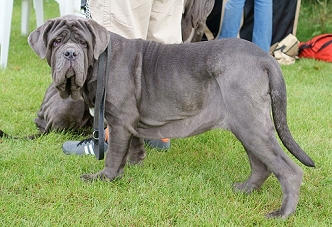
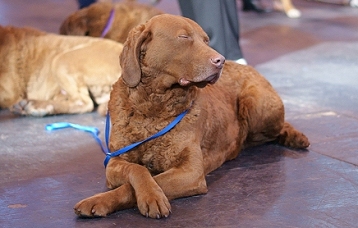

The four shades of eumelanin (clockwise from top left) - black, blue, isabella, and liver
Eumelanin is, by default, black pigment, like the Poodle above. All black areas on a dog are caused by cells producing eumelanin. However, there are genes which turn eumelanin into other colours - liver (brown), blue (grey), or isabella (a dusty pale brown). If a dog has any of the genes to turn its black eumelanin into liver, blue or isabella then all of the black in its coat will be changed. This is because these genes restrict and/or alter the production of eumelanin, so none of the cells are able to produce full-strength pigment. We call blue and isabella dogs "dilutes" for this reason.
As well as being found in the coat, eumelanin is present in the other parts of the dog that need pigment - most notably the eyes (irises) and nose. The nose will be black, liver, blue or isabella depending on the type of eumelanin the dog can produce. The colour in irises is produced by layers of pigment, and brown eyes like most dogs have (and like many people have too) are caused by black eumelanin in those layers. When a dog has altered/restricted production of eumelanin, the irises are also unable to produce full-strength eumelanin. This means that the dark pigment in the eye becomes lighter, and the eyes turn into a light brown colour, known as amber or gold. This isn't really a colour we find in human irises, but the closest we have are hazel eyes, which are a mixture of green and brown, and so appear lighter than normal brown eyes.

This shows the variation in colour of eumelanin. Black is the default, then it can be turned into liver by one set of genes, and black and liver
can be turned into blue or isabella by another set of genes. Blue is diluted black and isabella is diluted liver. Liver itself is not technically a dilute, however, and is caused by a change in the structure of the pigment.
When we talk of dogs that are "black pigmented", "liver pigmented", etc, we mean that is the colour of eumelanin that the dog can produce. Sometimes these dogs have no eumelanin at all in their coats (their skin cells produce only the other type of pigment, phaeomelanin), but we can usually tell what their "pigment colour" is by looking at their nose. A black nose means the dog produces black eumelanin, and so on.

Phaeomelanin


The second type of pigment is phaeomelanin. This is red pigment. The term "red" covers everything from deep red (like Irish Setters) to light cream, encompassing gold, yellow and orange. Whenever we talk of red, unless we're talking particularly about Setters, we mean the whole range of tan colours.
Phaeomelanin is produced only in the coat. It does not occur in the eyes or the nose, so any genes that affect the colour/intensity of phaeomelanin will not affect the eyes or nose. Only eumelanin occurs in those areas, and so only genes that affect eumelanin can affect the eye or nose colour.

This shows the variation in colour of phaeomelanin. Unlike eumelanin, it doesn't occur in two distinct colours (black and liver, with dilutes counting as shades of those), but rather just one colour, which
varies in intensity. The most intense phaeomelanin colour is Irish Setter red. The default colour is probably golden, with different genes causing it to be
more or less intense (i.e. telling the cells to produce a higher density of pigment particles, so making the colour stronger, or a lower density, making
the colour weaker, so lighter).
Interestingly, phaeomelanin is also responsible for ginger hair and freckles in humans.

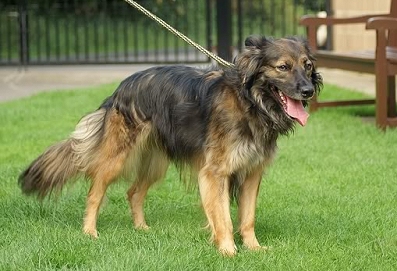
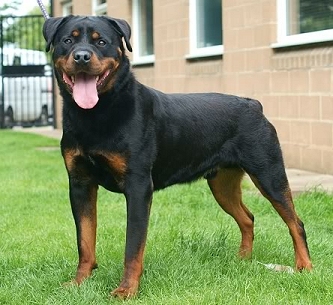
Most dogs have both eumelanin and phaeomelanin in their coats, as these two examples show. The first dog has a scattered mix of eumelanin and phaeomelanin (known as sable), and the second dog has much clearer boundaries between the two pigments. How the two pigments mix in the coat is mostly controlled by the A ("agouti") locus in dogs.

So far so good, but this doesn't seem to explain all the coat colours and patterns in dogs - how about white?

White
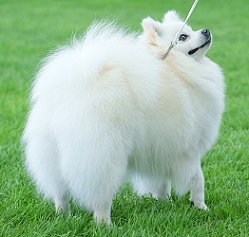
White isn't really a colour, so white hair on animals isn't caused by pigment but by a lack of pigment. In dogs it is a lack of both eumelanin and phaeomelanin. White areas on animals are simply caused when the cells cannot or do not produce any pigment at all. Sometimes the whole animal is affected, like in albinos, and sometimes just parts of it are affected, like in dogs with white markings. It can affect the production of eumelanin in eyes and noses too, turning noses pink and eyes blue (or red in true albinos). It's important to note that although albino always affects the whole animal, partial albinism does exist and is when the pigment production is drastically reduced, causing a paled coat colour instead of white.
There is also a second type of white, which is caused by dilution of red (phaeomelanin) pigment, making the cells produce fewer pigment particles than normal, so the colour gets lighter. If it is diluted enough, it can become white. Many white dogs have a slight ivory/cream sheen to their coats because their cells are still producing a very small amount of pigment (you can see this fairly clearly in the German Spitz above). This sort of white does not usually affect eumelanin, so any black/liver/blue/isabella areas on the coat will stay dark, and the eyes and nose will do too.

Distribution of Pigment
The colour genes in dogs do two things - they determine the eumelanin and phaeomelanin colours/shades, and they control the distribution of these two pigments. They tell certain cells to produce eumelanin, others to produce phaeomelanin, and sometimes they tell them to not produce pigment at all. Exactly which cells are told to produce what is determined by the exact set of genes, although it can be random to a certain degree (e.g. puppies may have slightly different white markings to their parents, or patches in different places). Sometimes genes can even tell cells to switch which type of pigment they are producing every once in a while. This means that as a hair grows, it becomes banded with black and red, because the cell produces black (eumelanin) for a while, then changes to red (phaeomelanin), then back to black, etc. The overall colour of an animal with this sort of black and red banding will generally be a muddy brown from a distance, and close up you will be able to see the black parts of the hairs. It's called agouti, and it's the colour of wild rabbits and mice, as well as a large amount of other mammals. It's widespread amongst wild animals because it provides very good camouflage.

Look closely at this wild rabbit and you'll see it's not just brown all over. The black-banded hairs break up the solid colour and make the animal much harder to spot, particularly in vegetation such as dead grass.

My own pet rat Archer is an agouti with blue (dilute) eumelanin. A number of different agouti variations have been bred into domestic animals, although these are very rare mutations in the wild.

Agouti also occurs in dogs, although it's fairly uncommon in most breeds. Dog agouti comes directly from wolves and is sometimes known as "wolf grey".
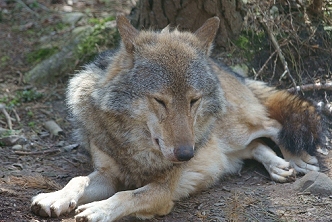
A captive wolf showing the agouti colouration. You may notice that the colour of this wolf is much less uniform than the rabbit above. Both are agouti (banded hairs), but the overall effect varies between species. On a wolf the banded hairs tend to be mostly concentrated around the back area, and this overall pattern can be seen in a number of other dog coat colours too, including sable and tan points (on the same locus as agouti in the dog genome). The ivory/white colour on the extremities often occurs with agouti in dogs and is known as "urajiro".

Pigment in Other Animals
Melanin is found almost all the way across the board, in mammals, birds, fish and insects, and even makes up the dark colour of squid ink. Our own skin, hair and eye colours are determined by melanin production, and melanin plays an important part in protecting our cells from harmful UV rays. In fact,
melanin (particularly eumelanin) has been found to play a part in health and immunity in a number of species. Hair and feathers are stronger and longer-lasting when pigmented with melanin, which is
one reason why many white birds have black wingtips - their flight feathers need to be durable.
Interestingly, the health link doesn't seem to be present to the same extent in dogs as in some species, and a black dog is no more or less healthy than any other colour.

This pelican shows black flight feathers on its wingtips. The melanin produced in these feathers makes them stronger than the white feathers elsewhere on the animal.
One of the most common mutations in wild animals is "melanism". This is when the coat is black all over, for example in black panthers (which are not a species of their own but just another name for a melanistic jaguar or leopard).

A melanistic wild rabbit on the island of Lunga in the Inner Hebrides (Scotland). Isolated populations of wild animals, such as those on small islands, are more likely to display unusual traits as this due to inbreeding and lack of predation. The mutation may have only arisen once, but then spread easily through the small population.

However, melanin is not the only pigment found in animals. For example, yellow in reptiles is produced by a pigment known as xanthin. Pigments can also be picked up from the environment rather than made by the animal itself - the most well-known example is that of flamingoes being pink due to carotenoid pigments in their diets, which are present in crustaceans. Interestingly, the pink colour of salmon is also caused by carotenoids obtained from their diet. In captivity, synthetic carotenoids have to be added to the diet of both flamingoes and salmon to maintain their colour (no one visiting a zoo wants to see a white flamingo, and grey salmon just aren't as appetising!).
Contrary to common belief, albinism is not actually a complete lack of pigment. It's just a lack of melanin-based pigment. In mammals, which generally only produce melanin, this does indeed result in the animal being completely white. However, in other animals different types of pigment remain unaffected. For example, an albino snake may be orange or yellowish due to its production of xanthin (yellow pigment) and/or erythrin (red pigment).


Photos provided by Bek Stobbart of Serenbach Exotics
Above are two Western hognose snakes (Heterodon nasicus). On the left is a "wild-type". "Wild-type" is a term used to refer to the standard colour of an animal, and in mammals, including dogs, this usually means agouti. The snake on the right is an albino, more correctly referred to as amelanistic ("without melanin"). The colour of the wild-type snake is made up of a combination of melanin (black), xanthin (yellow), and erythrin (red), but once the melanin is removed you can clearly see the layers of yellow and red pigment remaining on the albino. Notice how even the pupils are red, as albinos don't produce melanin in their eyes either.
As well as amelanism, reptiles can also be axanthic (no yellow pigment) or anerythristic (no red pigment), which all produce different phenotypes. A phenotype is how an animal looks due to its genes, as opposed to its genotype, which is simply a list of the genes/alleles it has regardless of whether these are visible in the animal.
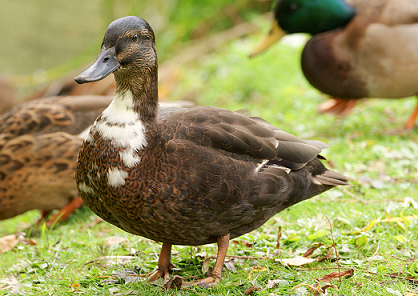
The mallard above is partially leucistic. Whereas albinism affects only melanin, there are other mechanisms that can affect all pigments, and leucism is a catch-all term for these. Albinism usually results when cells are faulty and unable to produce melanin, but the cause of leucism is generally to do with the "migration" of pigment cells
from the neural crest during the development of the embryo. If this is interrupted for any reason, the pigment does not migrate fully and non-pigmented or pale-pigmented areas result. Leucism can affect the whole animal or just patches (partial leucism), and most white markings seen in dogs are due to a form of partial leucism. It doesn't affect the eyes
because eye pigment doesn't come from the neural crest, and therefore leucistic animals generally have normal-coloured eyes rather than the pink/red eyes seen in albinos.


The penguin on the left here is a colour known as isabelline. This is a different form of leucism, where the pigment production is reduced rather than stopped entirely, causing a uniform "fading" across the animal. Notice how both the melanistic areas of the penguin (the grey and black areas) and the non-melanistic areas (yellow on the breast and red on the beak) are faded, as leucism affects all pigments.

The bright blue colour seen in this peacock occurs fairly frequently in birds, but in fact is not the result of a blue-coloured pigment. It is simply caused by the structure of layers of melanin in the feathers. When light hits these layers it reflects back as a blue colour, in the same way as iridescence.

All of this probably seems a bit confusing at this point. However, the information on this page really is crucial to your understanding of dog genetics (and the genetics of other animals too). Once you've grasped the idea of the two types of pigment, and understand how they work, the rest should be plain sailing.


** Please note that I am not a research scientist, and the information on this page comes from my own knowledge and observation of dogs, observational and testing data provided via e-mail by site visitors, any research papers linked on the page, and the information provided by Dr Sheila M. Schmutz on her excellent website http://homepage.usask.ca/~schmutz/dogcolors.html
For further genetics resources, see the Links page